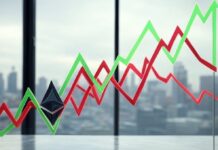This is a long-standing debate.
On Monday, Ripple received a notification letter sent by the SEC. Ripple officially released news that the U.S. Securities and Exchange Commission (SEC) plans to sue Ripple and accused it of selling XRP in violation of investor protection laws. This morning, the SEC officially announced that it has filed a lawsuit against Ripple, CEO Brad Garlinghouse, and co-founder Chris Larsen, accusing it of selling unregistered securities for $1.3 billion. When this lawsuit, which has not yet officially started, was passed to the domestic community yesterday, it was already regarded as a huge negative. After the news spread, XRP quickly fell by more than 20% in a short period of time, and the 24-hour lowest price has fallen below $0.4. The dispute about Ripple’s securities qualitative has been around for a long time, and the SEC has also moved frequently recently. Blocklike noted that, on the one hand, multiple large ICO offerings that have not yet been registered with the SEC are considered to be facing regulatory risks. On the other hand, since 2019, some of the compliant issuers approved by the US SEC are also trying to redefine them through new developments in the project.
Let’s talk about Ripple’s “legacy issues”, the chain reaction of the crypto community
XRP has always been regarded as a qualitative iconic currency for digital currencies. After several years of development, Ripple’s customers have covered at least 350 financial institutions in more than 40 countries. These mature business cooperations are regarded as one of the important value supports of XRP. Ripple’s RippleNet cross-border payment solution mainly includes the basic solution xCurrent provided by Ripple for financial institutions, which is used for real-time two-way settlement between different bank accounts. To put it simply, one party’s financial institution only needs to convert the local legal currency into XRP, and then the other party’s financial institution converts the received XRP into the country’s legal currency and pays it to the recipient. In this way, XRP can be used to reduce the liquidity cost of funds. This feature is described by analysts as a “stable currency for transfers”. If you do not consider the more elements that “cryptocurrency” incorporates into XRP, XRP is usually regarded as a relatively standard only in terms of the role of tokens. “Functional tokens” (also known as utility tokens). Under the US digital currency regulatory framework, this type of token and the “securities token” that need to be registered with the SEC are two completely different attributes. It is not difficult to understand the more mainstream views in overseas communities: “If XRP is also classified as securities, then most digital currencies will definitely be classified as securities.” This lawsuit is not a Ripple encounter. Ripple was not the first to arrive at a lawsuit directly filed by the SEC. According to incomplete statistics, as early as 2018, Ripple Labs encountered three collective lawsuits filed by investors. In 2019, two investors still filed class actions against Ripple. Even the California courts in the United States have combined the two lawsuits facing Ripple to avoid repeated trials by the same defendant. These lawsuits centered on “token attributes”, “whether the official has manipulated the market”, “serious centralization” and so on. The difference is that the focus of the dispute has not changed, and the source of the lawsuit has become the SEC. SEC officials believe that Ripple violated the federal securities laws when selling XRP. The lawsuit mentioned that, starting in 2013, Ripple continued to sell XRP to retail investors around the world to raise funds. Ripple also distributed billions of XRP in exchange for non-cash considerations such as labor and market making services. In addition to organizing and promoting XRP sales to fund the company’s business, Larsen and Garlinghouse also achieved unregistered personal sales of XRP, totaling approximately $600 million. After the currency price has fluctuated for more than 2 years, XRP has recently shown a dazzling performance in the market. According to coinmarketcap, since the beginning of this year, Ripple has risen by about 150%, and its market value has exceeded US$20 billion, ranking it third for a long time. As of press time, its market value ranking slipped to fourth place.
At this moment in time, the “conflict points” in this dispute seem to have been magnified. In the context of a more complex market, many industry organizations in overseas encryption communities have expressed their latest views, and many organizations have “stand in line”. Brad Garlinghouse, CEO of Ripple, insisted on Ripple’s consistent claims. He said: “The SEC is completely wrong in fact and law. XRP is a currency and not a security. XRP is the third largest virtual currency, which is in line with Bitcoin and Ethereum recognized by the SEC. The same is not an investment contract. In addition, the main departments of the U.S. government, including the Department of Justice and the Financial Crime Enforcement Network (FinCEN), have determined that XRP is a currency. Therefore, XRP transactions are not within the scope of the federal securities laws.” And Chief of Blockstream Strategy Officer Samson Mow commented that Ripple and XRP did not have any innovations, thus denying Ripple’s claim that “the SEC initiated a lawsuit against it because the US government and regulatory agencies cannot accept innovation.” Yoshitaka Kitao, the president of Japanese financial giant SBI Holdings, which invested in Ripple, said clearly: “The Financial Services Agency of Japan has made it clear that XRP is not a security. I am optimistic that Ripple will prevail in the final ruling in the United States.” And at the end of November. During the live broadcast, Ripple CEO Brad Garlinghouse made another assumption: “Although it is difficult to treat XRP as a security, if XRP is classified as a security in the United States, we have other G20 markets, and they have different views on XRP. More than 90% of RippleNet’s customers are not in the United States. In this regard, Blocklike interviewed Adi Sideman, the founder of Props, a US compliant issuer. His view is: “The impact of the SEC’s litigation on Ripple is negative and has no impact on the development of the industry Help. Ripple is a mature project with integration and use cases in the financial industry. The actions of the SEC will hurt the confidence of companies that will consider XRP or other encryption technologies. It will slow down real-world integration and new use cases, which in turn It will also slow down the application of encryption technology in the United States. I expect Ripple to settle with the SEC and continue to operate. But the SEC has also expressed its views and will prevent new projects from following in the footsteps of XRP (that is, operating without SEC exemption) To operate.”
Some “encryptionists” seek “second qualitative”
Last week, Coinbase Global announced that it had filed an IPO application with the SEC, which also brought a viable new way to characterize digital assets. Belcher, Smolen & Van Loo LLP lawyer Gabriel Shapiro publicly believes that the listing of Coinbase may enable the SEC to determine which tokens can be listed on the exchange. His analysis believes that the current SEC still does not have a clear rule, and the SEC should give priority to confirming the rules of “whether it constitutes securities” rather than stipulating which tokens are securities. Under the current circumstances, the SEC may even do this: if a certain token has not been filed with the SEC, the exchange cannot list these tokens. Interestingly, some quasi-digital securities that have been approved by the SEC are also seeking ways to redefine. Blockstack, the first in the United States to issue digital securities in compliance with the terms of “Reg A+”, is one such case.
In July 2019, the decentralized computing network Blockstack became the first compliance project approved by the SEC Reg A+ clause. On October 25 of the same year, Blockstack (STX) launched Binance, the leading digital currency exchange; at the end of July 2020, Coinbase issued an announcement stating that STX was also included in the 18 tokens being evaluated for listing. Muneeb Ali, co-founder and CEO of Blockstack (STX), told Reuters that Blockstack will officially launch its mainnet in January 2021: “Since Stacks 2.0 goes live, its network will no longer be controlled by any single entity. Therefore, according to SEC regulations, its Stacks tokens will no longer be regarded as securities. This means that Blockstack does not need to submit regular financial reports as the main body of the company, and its Stacks tokens can be traded on the US digital asset exchange. Adi Sideman, who has been in the US market for a long time, also discussed this approach. According to his point of view, in the United States, blockchain entrepreneurs need to frame encrypted assets as functional tokens or security tokens, either. “The language used is very clear. The positioning is either Security or Utility, but it is rarely mixed. However, the government sees more gray areas and new challenges in it, as we have in the case of Ripple and Kin. You see it.” According to Adi Sideman’s further introduction, this situation is common in this environment: “As a result, most of the projects in the United States are self-regulated-we carefully demonstrate our own technology and laws. We Props I chose a unique method, which is to classify our Token as Security in the United States, but as Utility outside the United States. Props as a whole is practical, but the SEC RegA+ exemption allows Props Under the US legal framework, it is allowed to integrate with mature American companies and applications with millions of users.” This may also be a new path chosen by many digital assets. What can be seen is that the entire crypto community seems to be ready to watch this lawsuit. As early as 2017, mainstream views generally believed that regulators would not treat crypto assets as securities. But with the passage of time, some views gradually changed and some views gradually evolved. Next, we may witness together, what role securities regulations and innovative projects will play in the blockchain industry.




